Most veterinarians are familiar with the idea of thermoneutral zones (TNZ) for animals, outlined by a lower critical temperature (LCT) and upper critical temperature (UCT). The subject is covered, for example, by Silva and Bittar (2019), and relates to the interaction between animal physiological states, nutrition, and external environment. It is broadly understood that when an animal moves outside its TNZ, there will be behavioural, energetic and physiological changes until TNZ is regained. What is not so clear is whether or not the cattle sector understands the dynamic nature of TNZ within and between 24-hour periods.
One example of the constant variability of the LCT/UCT limits of TNZ is the change in sensible heat production throughout a 24-hour period. Figure 1 shows the change in heat production during the first 15 hours of life for three different breeds of calf (Vermorel et al, 1983). The daily pattern of milk feeding, typically twice a day, will also influence daily changes in heat production (Hill et al, 2016). Body temperature will fluctuate as well, from the impact of depressed body temperature in dystocial calves (Vermorel et al, 1983) to the daily rhythmicity that establishes around day 9 in calves (Figure 2; Piccione et al, 2003). LCT and UCT may also change within 24 hours due to environmental variations in ambient air speeds and moisture levels in bedding.
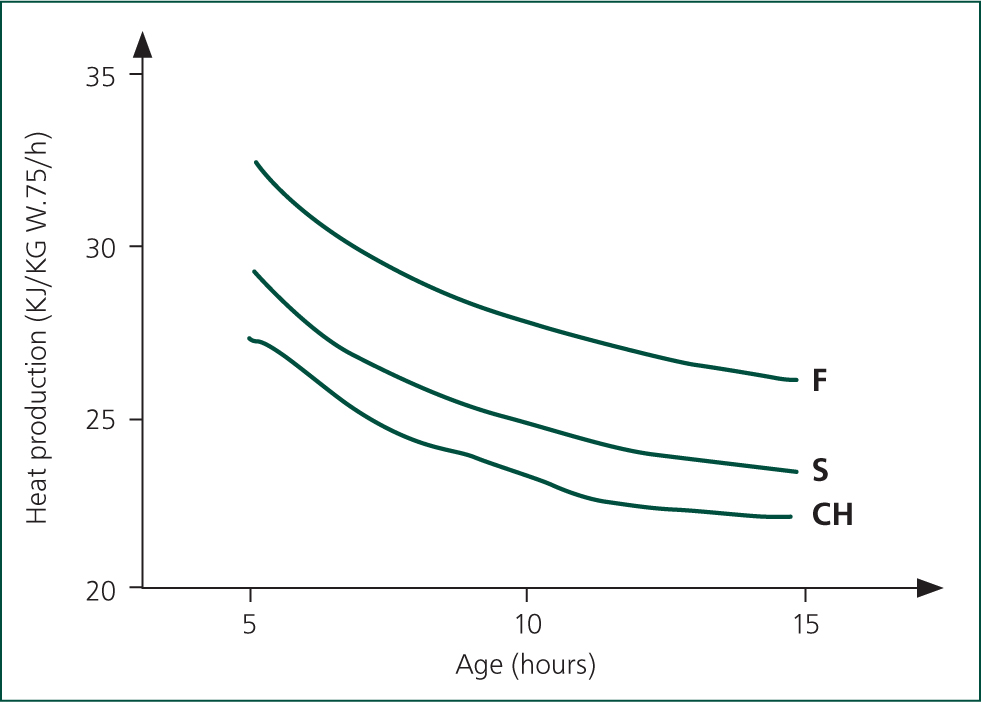
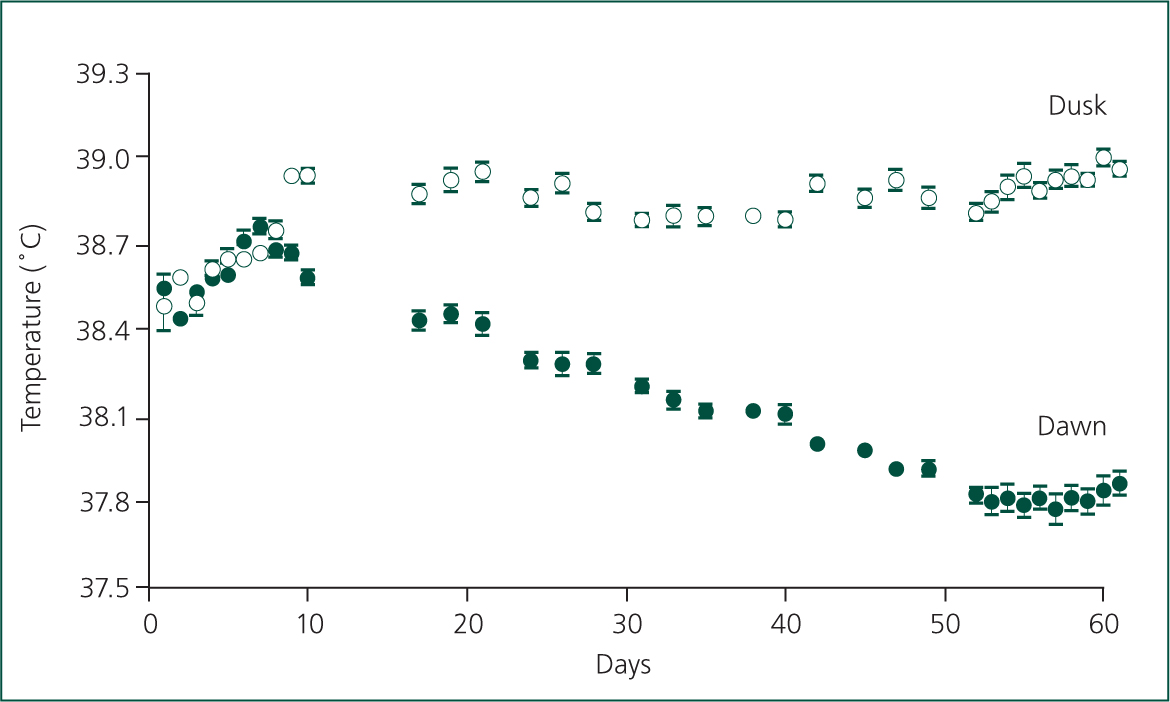
A healthy calf in its TNZ 24 hours a day cannot benefit from wearing a jacket, and at temperatures towards or exceeding UCT will at least suffer discomfort. The main management aspect of using calf jackets in the UK is related to LCT, and there is a high probability that young calves born during the winter months in the UK will at some point be below LCT. This probability is highest on the first day of life (d0), and diminishes by daily increments as LCT decreases (Table 1.)
Table 1. Effect of age of calf on lower critical temperature
| Age (d) | Critical temperature (°C) |
|---|---|
| 1 | 13.4 |
| 5 | 12.2 |
| 10 | 10.8 |
| 15 | 9.5 |
| 20 | 8.4 |
| 25 | 7.3 |
| 30 | 6.4 |
Various values are cited in the literature for calf LCT, and this variety understandably causes confusion. The LCT of calves will be different even at the same age if they have different birth weights, subcutaneous fat depth, hair follicle density, degree of piloerection, feed quantity, feed composition and feed energy density. LCT is not a static value but, for management purposes, it is more functional to use basic values, and express the LCT of healthy calves as between 15oC and 5oC in the first 4 weeks of age. The LCT of unhealthy calves is likely to be lower, with Azzam et al (1993) reporting from records of more than 83 000 births of beef calves that there was a five-fold increase in mortality in calves born to cows with dystocia, that half of all mortalities were associated with difficult births, and that there was a negative effect of precipitation on the day of birth on calf survival rates. The negative impact of precipitation on survival rates increased with decreasing air temperature. These factors all link through thermal dynamics, as does the impact of feeding rates. Colostrum quality and management will have a direct impact on individual calf TNZ. Dubrovsky et al (2019) investigated the records of 11 470 calves from six dairies in the USA, and found that feeding ≥5.7 litres of milk per day per calf vs. ≤3.7 litre/day significantly decreased the risk of mortality in calves over 21 days of age. A calf jacket can be complementary to nutrition because it has the basic ability to influence the thermal dynamics of any calf below its LCT, and thereby impact on growth rates and physiological impacts of ‘cold stress' (Rawson et al, 1989; Silva and Bitta, 2019).
Trial data
There have been a relatively small number of published trials carried out on commercial farms or research facilities in the UK. The basic data presented in these trials are summarised in Table 2. Earley et al (2004) saw no significant differences in daily liveweight gain (DLWG) after 62 days of jacket/no jacket with jackets removed on d42, with a mean trial DLWG of 0.8 kg/day. There were no differences in white blood cell counts or serum immunoglobulins between calves with or without jackets outdoors. Calves went on trial at an average age of 19 days.
Table 2. Studies of the relative performance of calves with and without jackets
| Study | Date | Number of calves | Age on trial | Age off trial | MR | Concentrate | DLWG | Significance | Comments | ||||
|---|---|---|---|---|---|---|---|---|---|---|---|---|---|
| Control | Jacket | Other | g/d | g/d | %CP | Control g/day | Jacket g/day | ||||||
| Earley et al | 2004 | 30 | 30 | 30 | 19 | 61 | 600 | Ad lib | n/a | 808 | 801 | NS | High BRD treatment rate |
| Matsuda et al | 2011 | 11 | 11 | - | 300 | +5.5 h | 0 | 0 | n/a | n/a | n/a | <0.05 | Winter transport. Significant differences in physiological parameters |
| Downie | 2013 | 16 | 17 | - | 0 | 42 | 810 | Ad lib >d7 | 17 | 230 | 440 | <0.05 | Calves with scour only, week 1 |
| Williams | 2015 | 10 | 10 | - | 0 | 28 | 500 | Ad lib | 19.50 | 510 | 570 | <0.05 | |
| Marsh et al | 2017 | 20 | 20 | - | 17 | 42 | 750 | Ad lib | 18 | 644 | 713 | NS | |
| Bleach et al | 2017 | - | 20 | 20 | 0 | 21/42 | 900 | Ad lib | 18 | - | 64015902 | NS | 1 jackets for 21 days2 jackets for 42 days |
| Scoley et al | 2019 | 46 | 44 | - | 0 | 21 | 600–750 | Ad lib | n/a | 490 | 480 | NS | DLWG from d7 to d20 |
| Rutherford et al | 2020 | 20–25 per repetition | - | 30.9 | 80 | 600–640 | Ad lib | 16 | 880 | 860 | NS | Four repetitions on farm | |
DLWG = daily live weight gain, BRD = bovine respiratory disease
Jackets were used during 5.5 hours of winter transport of healthy 10-month-old commercial black cattle in Japan in temperatures around 0oC (Matsuda et al, 2011). The work describes significant improvements in indicators of physiological stress when compared with young cattle transported without jackets. Serum vitamin A concentrations were reduced after transport in both groups, but significantly less reduced in the group with jackets. There were significant increases in cortisol after transportation but, again, this was a significantly lower increase for the jacket group. The group wearing jackets during transport had fewer recorded health disorders in the period after transport than the control group, with the authors concluding that the jackets had a positive influence on immunocompetence.
Downie (2013) measured growth rates and health of 33 dairy heifer calves randomly assigned to jacket/no jacket treatments at d0 on a commercial farm (Figure 3). The mean ambient air temperature during the 6-week period was 6.9°C, with 84% of the time at <9°C and 23% of the time at <5°C. Calves wearing jackets gained an extra 0.21 kg/day (p<0.05) during the first week of life but all calves had positive scores for diarrhoea (Calf Health Scores, University of Wisconsin-Madison). These results are further confounded by the fact that seven calves in each treatment group were given antibiotics for symptoms of respiratory disease. The variability of the growth rate data was high, with coefficients of variation (CV) for DLWG from d0 to d6 of 185 and 101 for the no jacket and jacket groups respectively. Health issues on the farm will have influenced the variability of the data. A similar study from d0 involving 20 calves on a commercial unit over a 12-week period from January to April (Williams, 2015) described mean air temperatures of 8.4°C. There was a positive significant effect of jackets, with a mean DLWG of 570 g/day compared with 510 g/day from d0 to d28 and a non-significant difference of +104 g/day from d0 to d56. Control calves consumed more concentrates from d15. All calves had at least 1 day of treatment with antibiotics during the study period, but there was no significant difference between the two groups in the average number of days of treatment per calf.
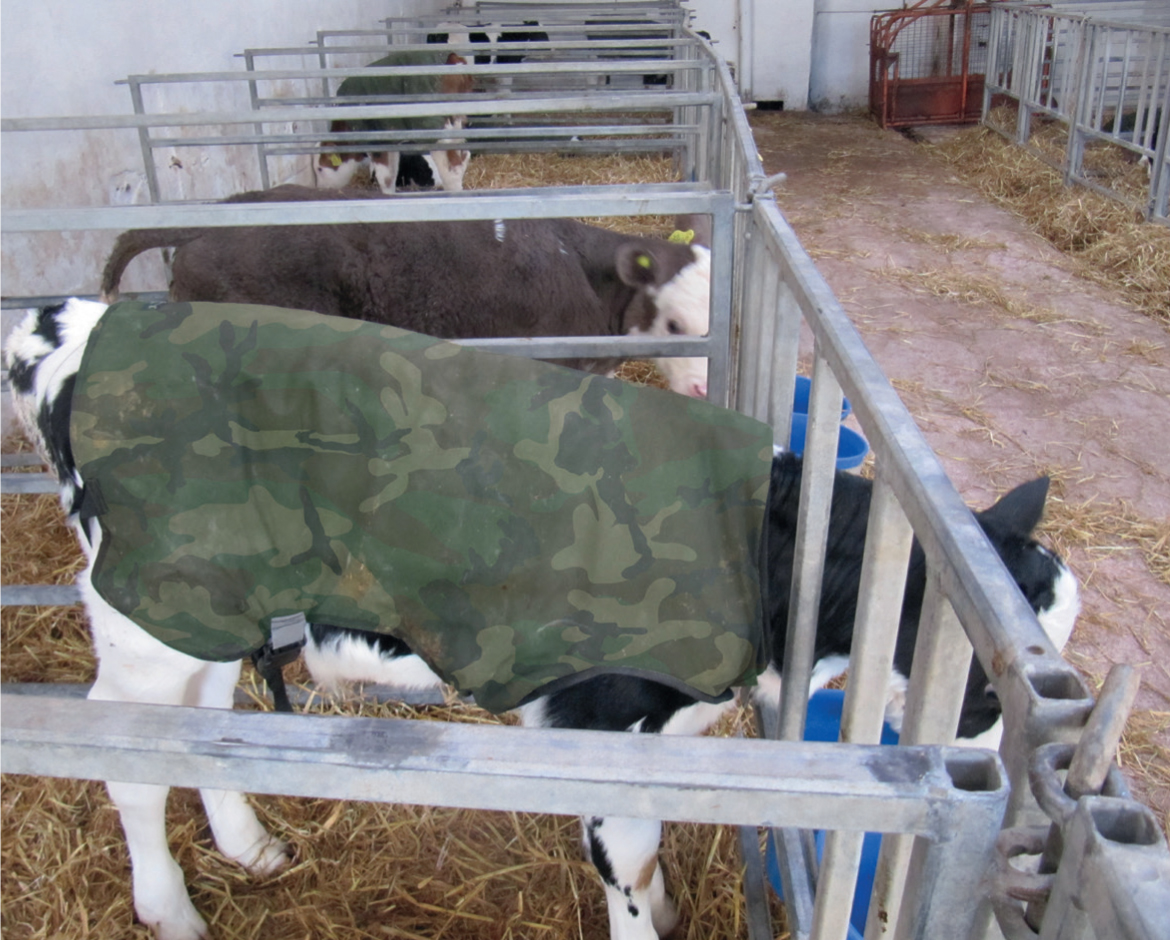
Marsh et al (2017) used jackets on purchased calves on trial with no jacket controls from d17 to d42, individually penned. There were no significant differences in DLWG between the two groups at any point, although calves with jackets had higher growth rates throughout the trial in spite of ad-lib access to concentrates (Table 2). There was a positive significant difference (p=0.021) for calves with jackets in mean last rib girth measurements of 103.3 cm vs. 107.6 cm, which is considered to indicate rumen development. There were no significant differences in health scores apart from diarrhoea, which showed a reduction of incidence to 25% compared with 57% of calves with no jackets.
Bleach at al (2017) found no significant differences in DLWG or treatments for bovine respiratory disease (BRD) or diarrhoea between heifer calves with jackets from d0 to d21, or d0 to d42. Ambient temperatures ranged from a mean maximum of 9.2°C to a mean minimum 1.8°C. By day 21, an average healthy calf would be within the TNZ for most of the recorded temperatures.
The authors suggest that there are no detrimental impacts of using a jacket on calves for 3 weeks compared with 6 weeks, whereas Scoley et al (2019) measured a significant negative difference in feed conversion ratio (FCR) for the week following jacket removal on d21 between jacket and no jacket control calves. Scoley et al (2019) introduced treatments from day 1 and, while there was no difference in DLWG between jacket and no jacket controls, dry matter intakes (DMI) were significantly increased for calves with no jackets.
Rutherford et al (2020) examined the impact of jackets on health and performance of dairy origin beef calves with and without jackets. Calves were assigned to treatment on arrival at a calf rearer. There was no treatment effect on health or performance, with mean DLWG across all treatments of 0.86 kg/day. The major issue with this work and the earlier studies of Earley et al (2004) and Marsh et al (2017) is that calves are introduced to treatments at an age when a healthy calf would have an LCT of maybe 5°C.
The work of Matsuda et al (2011) demonstrates the importance of considering thermal dynamics, whereby a 10-month-old healthy bovine on farm would normally have an LCT well below 0°C, and where the increased insulation provided by a jacket would typically have no positive impact on physiological state. However, convective heat transfer coefficient increases with air speed (Li et al, 2016) and, as a result, the LCT of an animal exposed to increased air speed will lose sensible heat faster than one housed in a reasonable design of building. Air speeds within livestock transport are recorded between 2.1 and 1.3 m/second dependent on location within the vehicle, with a direct relationship to driving speed and variance above these values (Gerritzen et al, 2013). One interpretation of the study by Matsuda et al (2011) is that the 10-month-old cattle were thermally stressed during some parts of the transport journey, and that the jackets provided increased insulation, effecting a beneficial change in convective heat transfer coefficient.
Published data on the use of calf jackets have not been entirely clear as to overall outcomes. Of the eight studies cited in this article, four are of little value because animals went on trial at an age where little or no benefit might be expected from the added insulation provided by a jacket. Of the remaining studies using jackets from d0, the combination of energy intakes and ambient air temperatures suggest that any differences in DLWG between groups might be small. This observation, alongside the variability of the data as defined by standard errors of difference and coefficients of variation, suggests that further trials should increase control of more variables or increase calf numbers on trial. All calves apart from the study by Downie (2013) had access to adlib concentrates from d0 but only two studies measured intakes.
All calves in Bleach et al (2017) had jackets, and the difference in jacket/no jacket treatment only started from d21, by which time the probability of energy deficiency caused by a lack of external insulation will have been low. Scoley et al (2019) did measure a significant increase of 0.53 kg DMI in concentrates between d7 and d20 in calves with no jackets compared with calves with jackets.
Jackets on farm
The gap between the scientific evidence for the value of calf jackets compared with a degree of popularity on UK commercial farms may be regarded as contradictory. In a survey of dairy farmers in 2015 by Kingshay Dairy Specialists, 66% of respondents who used jackets on calves did so with the aim of increased growth rates; 46% used them to reduce disease levels, and 16% to reduce feed costs (Kingshay, 2015; Figure 4). Reasons for choosing a particular jacket are shown in Figure 5. The mode period for keeping jackets on was 4 weeks and 38% of survey respondents did not use jackets because they did not expect to gain any benefits from them.
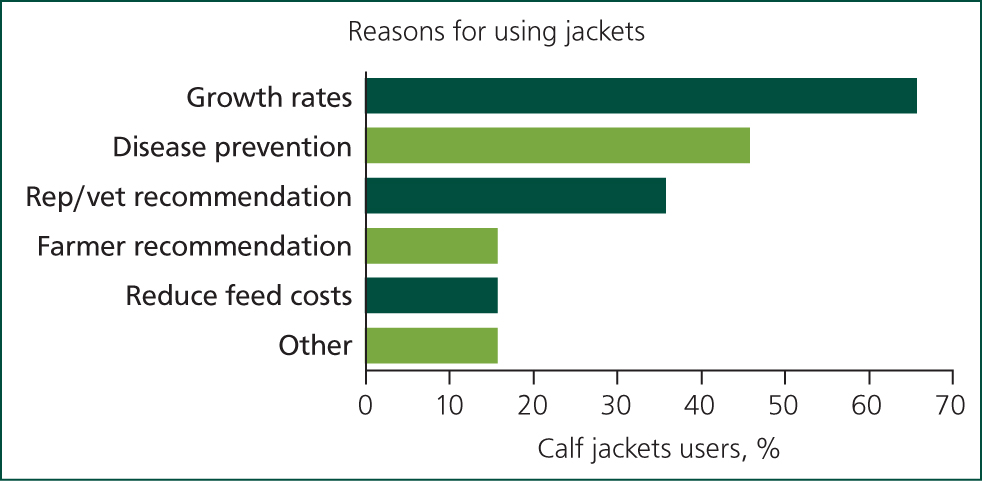
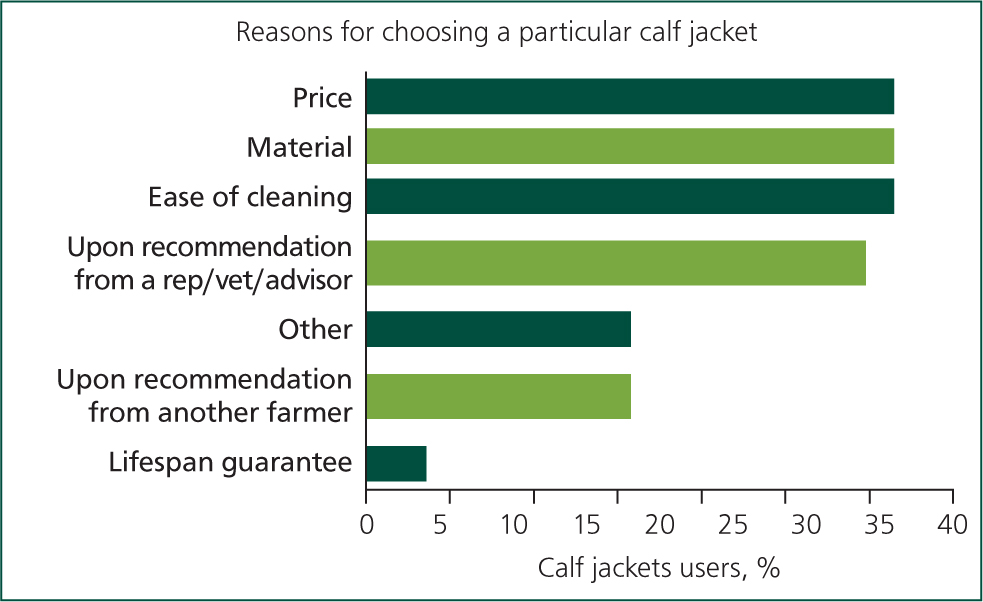
In a survey carried out by Williams (2015), 32% of 100 cattle producers indicated that they used jackets, but with no pattern of use associated with breed. This suggests an opportunity to promote jacket use for the smaller breeds, where thermal pressures will be more extreme than for larger breeds. In a survey of 75 Welsh dairy farms in 2015, Atkinson (2015) reported that although a relatively new concept, 46% of farms were using calf jackets and 84% of those users were positive about them. The only negative comments were about the practicalities of cleaning the jackets, which by 2020 has still not been clearly addressed.
Jacket design
The original design of calf jacket used in Aberdeen was a composite Ventile-type waterproof cotton and alpine fleece made bespoke by the Firemore Outdoor Clothing Company in 2012 (Figure 6). Since then, there has been a rapid increase in the range of products available (Figure 7) and not all represent good value for money. Size, straps and buckles are not all suitable (Figure 8).
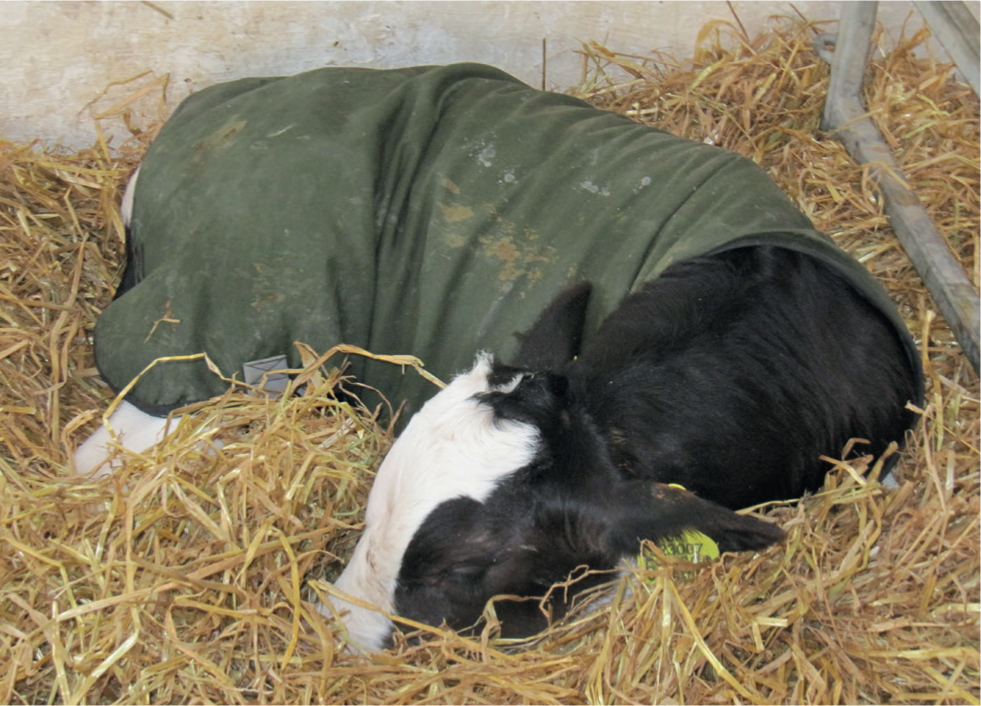
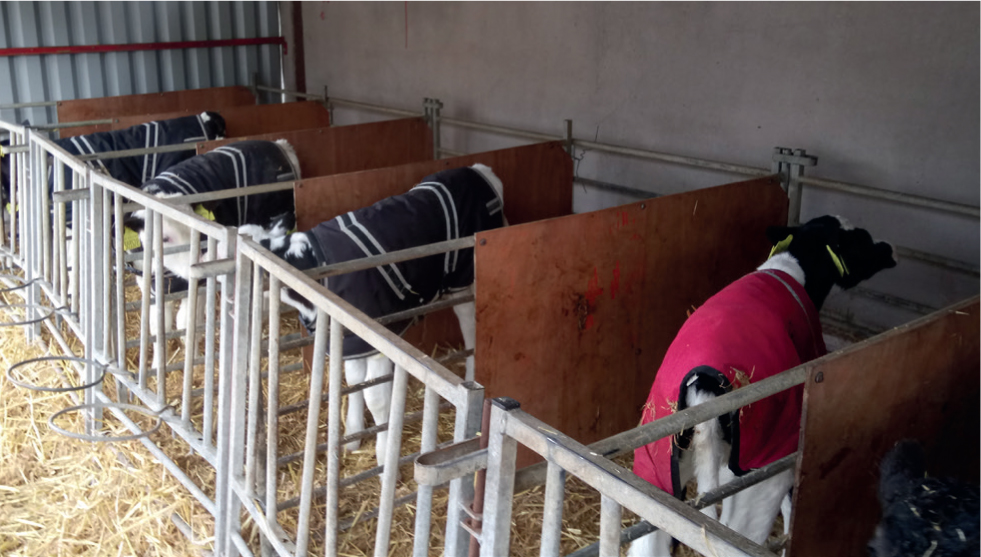
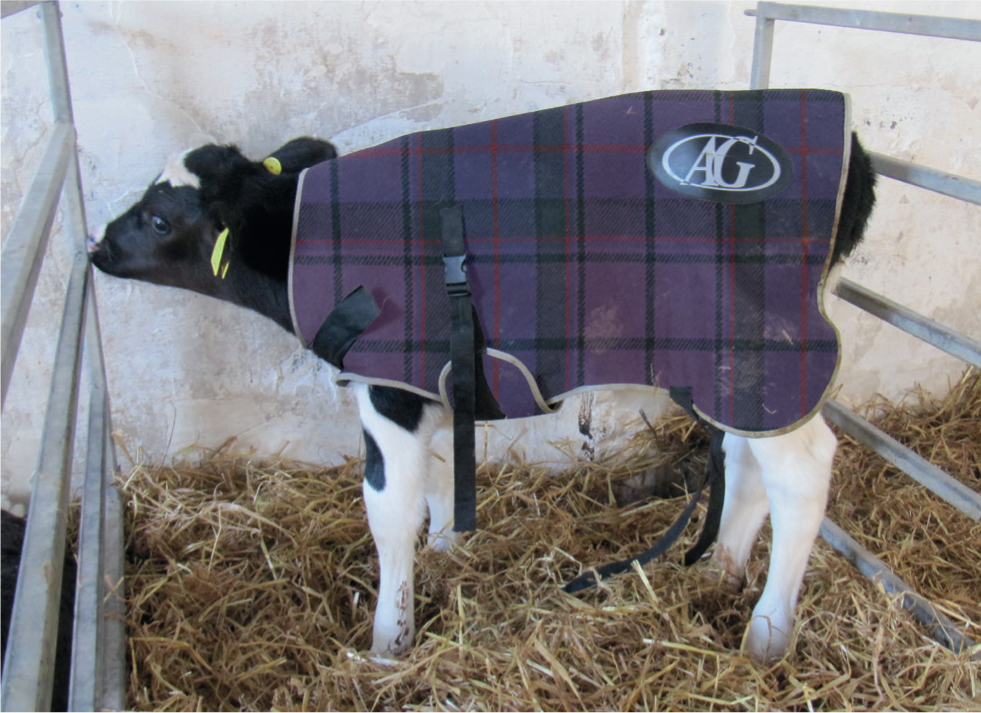
The prime requirements of jackets are:
- Breathable
- Well-fitting and easy to fit
- Water-repellent (Figure 9)
- Washable
- Durable.
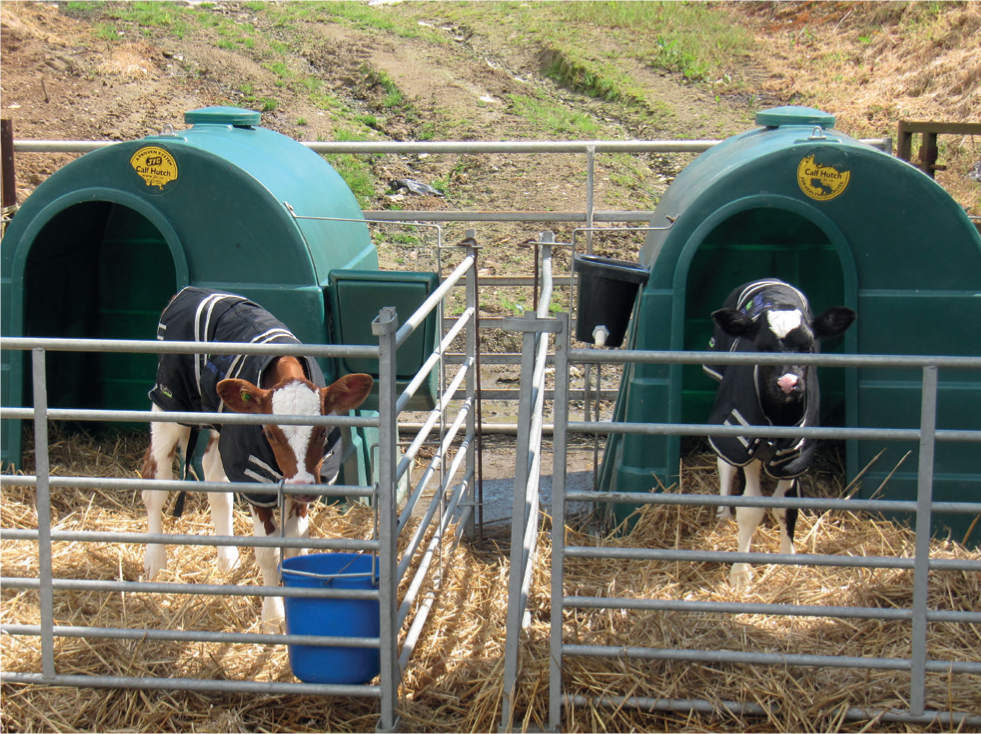
Price is not an issue for the producer because there are one or two products on the market that fulfil the design requirements and are likely to repay the investment within 7 or 8 uses, based on an increased DLWG of 50 g/day for 28 days of jacket use. Products that are less viable in the commercial environment are jackets made of single-layer materials, inappropriate fixings such as Velcro, non-breathable materials, products that are difficult to wash, and those that are not durable. A jacket that does not wick moisture away from the body surface and then away from the jacket will be worse than no jacket at all when ambient temperatures fall at night.
Hygiene
Guidance on cleaning jackets needs to be clear, and what was clear from the start was the following: ‘do not advise use of calf jackets on farms where you think the client is unlikely to wash them correctly’. Jackets may need an initial clean using a hose or low-pressure powerwash to remove gross debris, then washed in a machine at 60°C with detergent, and dried (Figure 10). Specific disinfectants may be required if, for example, Cryptosporidium is a problem on a farm. General guidance is available from the Agriculture and Horticulture Development Board (2018). Basic hygiene requirements are carried out routinely on some farms, but there is a major need for the veterinary profession to encourage better hygiene on other farms where calf jackets are used (Figure 11).
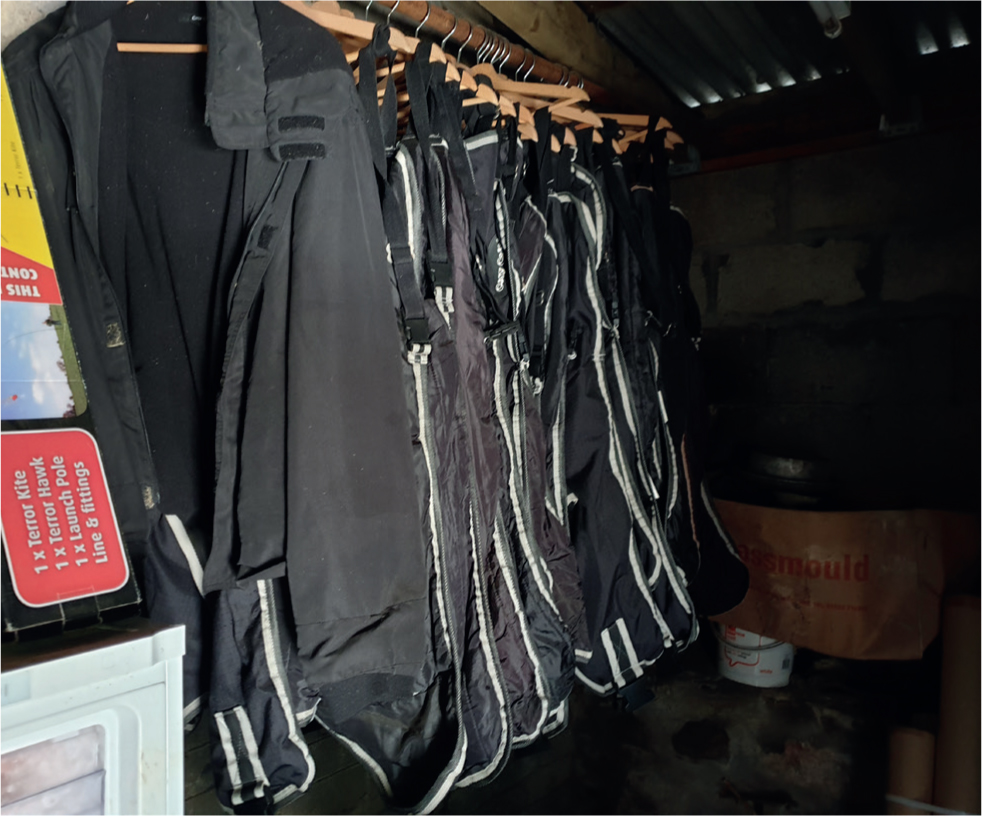
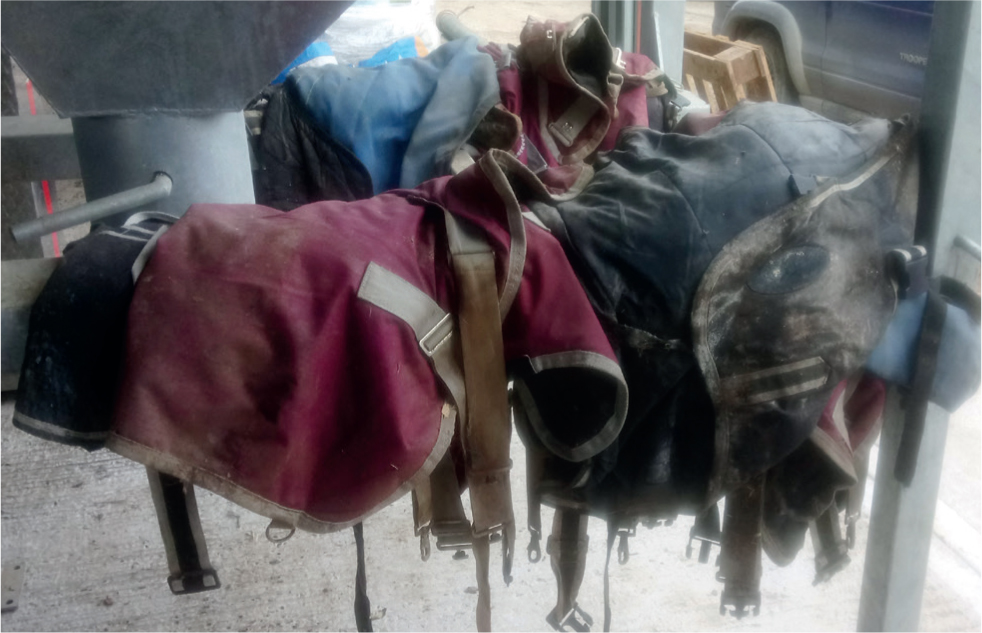
When to start/stop using jackets?
On the basis that producers need robust and clear information, a protocol for calf jacket use and cleaning is shown in Box 1. It might be appropriate to encourage more pragmatic management decisions based on the energy dynamics discussed above. What is the condition and appetite of each calf?
What are the expected weather conditions? Putting jackets on a calf on d0, once it has been dried, is an easier decision than when to take it off — particularly during the winter months.
The decision to take a jacket off a calf should be a result of a rapid analysis, as outlined in Box 1. However, if a simple set of rules are required, the following may be useful:
- No healthy calf over 3–4 weeks of age should have a jacket on when there is calf on the same farm less than 7 days old that does not have a jacket
- Remove all jackets from healthy calves at 4 weeks of age in winter months
- Clean jackets immediately after use.
Box 1.Calf jacket protocolIn the first week of life, a calf is likely to spend extra energy to keep ‘warm’ below an air temperature of about 10°C. The actual LTC for any one calf will depend on all those aspects that will influence the energy dynamics of the system:
| Genetics — | Jersey calf will feel ‘cold’ before, e.g. Charolais calf |
| Birth conditions | — normal/prolonged; premature/low birth weight; single/twin |
| Health — | vigour/health vs apathetic/low feed intake |
| Nutrition — | quality and quantity and timing of colostrum; energy density and dilution of milk powder, adequate intake |
| Air speed — | less than 0.2 m/second is good; a draft is negative |
| Dry bedding — | essential; damp bedding extracts energy from the calf |
Jacket on — seasonalJackets must be made of breathable materials:
- Locate maximum/minimum thermometer in calf house
- Reset thermometer every morning during autumn/winter housing
- Decide on set temperature for your system, e.g. 10°C
- Agree starting protocol with staff, e.g. three consecutive night-time minimum temperatures below 10°C
- Calves must be dried off before using jacket
- Place clean jacket on every calf below 1 week of age and on entry to calf house.
Jacket on — sick calfA calf with reduced feed intake and an increased body temperature will have an increased LCT compared with a healthy calf. Refer to ambient air temperatures and use a jacket on a sick calf at day-time temperatures below 15°C.Jacket offEntirely dependent on the energy dynamics listed herein. What is the condition and appetite of each calf? What are the expected weather conditions? Or keep on calf until 4 weeks old.
- Know the weather forecast; steady or rising temperatures OK; falling temperatures, beware removing jacket too early
- Agree with staff a temperature protocol for healthy calves e.g. 1-week old >10°C OK; 2-week old >7°C OK; more than 3 weeks old >5°C OK
- Refer to recent night-time minimum temperatures
- Consider individual calf condition; feed intake, health, growth rate
- Remove jacket in morning, not afternoon
- Remove dirt from jacket with hose/light powerwash or pre-soak
- Wash jacket at 50–60°C with detergent, disinfectant if required, and dry.
Scoley et al (2019) showed that when jackets were removed at d21, calves showed a plateau in DLWG over the following week compared with calves without jackets from d0. This may be related to the fact that calves with jackets may have had a reduced subcutaneous fat level compared with no jacket calves (Rawson et al, 1989). Calves with no jackets will have a longer period of physiological adaptation to cold temperatures than calves with jackets, with a subsequent negative impact if jackets are removed when individual calves are below LCT. This informs the suggestion to remove jackets at 4 weeks of age in UK winter conditions, as a generality.
Future use
Current calf systems need upgrading in terms of facilities and management. Colostrum and feed management are improving, but targets are not universally achieved in practice, not least because increasing herd sizes have resulted in less time and priority for calves (Santman-Berends et al, 2014). Calf jackets have a role where their function is understood, and basic hygiene management is accepted and applied. Calf jackets are a low-cost, high-value product that allow for flexibility in their use on individual and group calves. With intelligent use, they can contribute to improved efficiency of resources and health, and drive down antibiotic requirements.
Conclusions
Jackets are only advantageous on calves where there is a thermal benefit from the added insulation value and protection from increased air speeds. The published data involving jacket use are not especially useful, as half involve older animals with low probability of impact, and access to ad-lib feed was universal but only quantified in two studies. However, jacket use was associated with improved growth or FCR, and some health parameters where jackets were used from d0. Feedback from farm surveys is generally positive, but there may be a need to reinforce the biosecurity issues surrounding poor hygiene practice. Any further trial work needs to employ sufficient numbers of animals and acknowledge the expected variability of growth data in calves that are not genetically or physiologically the same. The alternative with trials using smaller numbers of calves will be to control or measure more of the independent variables such as environmental parameters and daily total energy intakes.
KEY POINTS
- Calves in UK winter conditions are likely to be thermally challenged.
- Jackets should only be used if they are clean and made of breathable material.
- The scale of benefit from calf jackets will depend on ease of calving, level and quality of early nutrition, calf health, and air temperature, air speed and humidity.
- Jacket removal should be at around 4 weeks of age but should recognise individual calf health and imminent weather conditions.
- Jackets should always be washed after every calf, to 60°C, with disinfectant added if Cryptosporidium is a problem, and allowed to dry completely.


